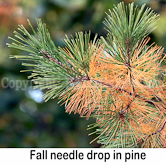 Every
autumn, gardeners see brown needles form in often
startling numbers on their pine trees. This is
especially true of certain species such as Eastern white
pine (Pinus
strobus). There first reaction is something
like, "What the heck is happening to my pine! Is it
dying?"
Every
autumn, gardeners see brown needles form in often
startling numbers on their pine trees. This is
especially true of certain species such as Eastern white
pine (Pinus
strobus). There first reaction is something
like, "What the heck is happening to my pine! Is it
dying?"
The good news is that the
answer is usually a resounding, "No! Your tree is not
dying."
Although they are called
evergreens, the fact is that the needles on these plants
only last a certain length of time. Then, they turn
brown and drop off the plant to be replaced by new
foliage. The number of years the needles last varies
from species to species. Some take 8 to 10 years to
replace all their needles while some like the white pine
take only about 3 years.
That means that for these
trees, some years what appears to be a very large number
of needles turn brown and drop. This happens most
intensely in the fall just as the leaves of deciduous
trees start to drop too.
The key to determining if
your tree is in trouble or if it is just going through
the normal dropping of old needles is the location of
the needles that are affected.
If the needles at the
tips of the branches are still green, flexible and look
good and the brown needles are closer to the trunk...it
is just needle drop. The older needles are always the
ones in closer to the trunk. Also, they will just be a
uniform brown in color with no telltale orange rings or
spots which would indicate a fungal infection.
If the needles at the
tips of the branches are brown...it is a problem.
Disease, droughts and other stresses tend to hit those
at the tips of the branches first.



